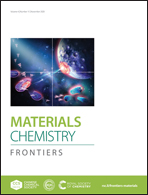Fine-tuning the energy levels and morphology via fluorination and thermal annealing enable high efficiency non-fullerene organic solar cells†
Abstract
Non-fullerene acceptors have been utilized to construct efficient organic solar cells (OSCs). In this work, two new acceptors, TPQx-4F and TPQx-6F, with quinoxaline (Qx)-fused rings, were designed and synthesized. The single-junction inverted OSC devices based on two NFAs, blended with PM6 as the polymer donor were systemically investigated. The introduction of fluorine atoms into the Qx-containing fused central framework not only downshifted the energy levels, but also greatly optimized the morphology of PM6:TPQx-6F blend films. The power conversion efficiency (PCE) of the PM6:TPQx-4F based devices improved from 6.78% to 7.72% through thermal annealing (TA) treatment. Meanwhile, the PM6:TPQx-6F based devices showed a PCE of 12.10%, in which a remarkable PCE of 14.30% was obtained after TA treatment. The different performances of the devices based on PM6:TPQx-4F and PM6:TPQx-6F were mainly attributed to the variation of the short-circuit current density (Jsc) and fill factor (FF). Further investigations indicated that the PM6:TPQx-6F blend films presented higher mobilities, and more efficient charge dissociation and uniform nanophase separation than those of the TPQx-4F-based devices, leading to higher Jsc and FF. In addition, enhanced Jsc and FF were simultaneously realized by simple TA treatment for the TPQx-4F- and TPQx-6F-based devices. This work provides more insight into the underlying reasons behind fine-tuning the energy levels and optimizing the active layer morphology in high-performance OSCs.



 Please wait while we load your content...
Please wait while we load your content...